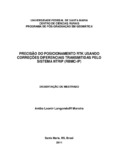| dc.creator | Moreira, Antão Leonir Langendolff | |
| dc.date.accessioned | 2012-03-06 | |
| dc.date.available | 2012-03-06 | |
| dc.date.issued | 2011-03-18 | |
| dc.identifier.citation | MOREIRA, Antão Leonir Langendolff. Accuracy of RTK positioning using differential corrections transmitted by the system NTRIP (RBMC-IP). 2011. 93 f. Dissertação (Mestrado em Geociências) - Universidade Federal de Santa Maria, Santa Maria, 2011. | por |
| dc.identifier.uri | http://repositorio.ufsm.br/handle/1/9547 | |
| dc.description.abstract | The Global Navigation Satellite System (GNSS), in the last few years, has been
supporting the development of mobile telephony and the expansion of electronic
equipments (GNSS receivers) to promote a revolution in geodetic surveys in real time.
In this context, it becomes important the technique of positioning Real Time
Kinematic (RTK) with the use of differential corrections transmitted by the protocol
named Networked Transport of RTCM via the Internet Protocol (NTRIP), from a
reference station via Internet. It is aimed, in this research, the evaluation of the
precision of this technique for different lengths of baseline, and also the use of
different numbers of trace periods. Then, three-dimensional coordinates of 10
stations (DEM) were used, they were also located in three municipalities of Rio
Grande do Sul, which were traced by the static post-processed (static PP) method,
which helped as being a reference in comparison with technique RTK / NTRIP, that
used the correlations of the Brazilian Network for Continuous Monitoring of the GNSS
Systems in real time - (RBMC-IP). The results showed that there was resolution of
the ambiguities in nine seasons at baseline greater than 54 km, and that the
precision values showed no difference greater than 0.041 m in the horizontal
component and 0.083 m in the vertical component. In addition, between the numbers
of the tested periods (5,10,30, 60 and 120 periods) for the method RTK / NTRIP, the
tested period that had the best average precision of the horizontal component was
the 120 one (0.01 m), and for the vertical component was considered the five periods
number as the most appropriated (0.02 m). Hence, it was proved the reliability of the
technique RTK / NTRIP (RBMC-IP) in baselines of until 54 km, showing that it can be
used for topographical surveys in areas with wireless Internet or cellular services
such as GPRS, GSM and 3G. | eng |
| dc.format | application/pdf | por |
| dc.language | por | por |
| dc.publisher | Universidade Federal de Santa Maria | por |
| dc.rights | Acesso Aberto | por |
| dc.subject | RTK | por |
| dc.subject | NTRIP | por |
| dc.subject | RBMC-IP | por |
| dc.subject | GNSS | por |
| dc.subject | DGPS | por |
| dc.subject | RTK | eng |
| dc.subject | NTRIP | eng |
| dc.subject | RBMC-IP | eng |
| dc.subject | GNSS | eng |
| dc.subject | DGPS | eng |
| dc.title | Precisão do posicionamento RTK usando correções
diferenciais transmitidas pelo sistema NTRIP (RBMC-IP) | por |
| dc.title.alternative | Accuracy of RTK positioning using differential
corrections transmitted by the system NTRIP (RBMC-IP) | eng |
| dc.type | Dissertação | por |
| dc.description.resumo | O Sistema Global de Navegação por Satélite (GNSS) nos últimos anos vem se
apoiando no desenvolvimento da telefonia móvel e no avanço da eletrônica dos
equipamentos (receptores GNSS) para promover uma revolução nos levantamentos
geodésicos em tempo real. Neste contexto, se destaca a técnica de posicionamento
Real Time Kinematic (RTK) usando correções diferenciais transmitidas pelo
protocolo Networked Transport of RTCM via internet Protocol (NTRIP), a partir de
uma estação de referência via internet. O objetivo deste trabalho foi avaliar a
precisão desta técnica para diferentes comprimentos de linha de base e com o uso
de diferentes números de épocas de rastreio. Para isso, foram utilizadas as
coordenadas tridimensionais de 10 estações (marcos), localizadas em três
municípios do estado do Rio Grande do Sul, rastreadas pelo método relativo estático
pós-processado (estático PP), o qual serviu de referência na comparação com a
técnica RTK / NTRIP, que utilizou de correções da Rede Brasileira de Monitoramento
contínuo dos Sistemas GNSS em tempo real (RBMC-IP). Os resultados mostraram
que houve resolução das ambiguidades em nove estações numa linha de base
superior a 54 km e que os valores de acurácia não apresentaram diferença superior
a 0,041 m na componente horizontal e 0,083 m na componente vertical. Além disso,
entre os números de épocas testados (5, 10, 30, 60 e 120 épocas) para o método
RTK / NTRIP, aquele que apresentou a melhor média de acurácia horizontal foi o de
120 épocas (0,01 m) e para a componente vertical o melhor resultado foi alcançado
com o número de 5 épocas rastreadas (0,02 m). Deste modo, foi comprovada a
confiabilidade da técnica RTK / NTRIP (RBMC-IP) em linhas de base de até 54 km,
podendo ser utilizada para levantamentos topográficos em locais providos por
Internet wireless ou serviços de telefonia celular tais como, GPRS, GSM e 3G. | por |
| dc.contributor.advisor1 | Sebem, Elódio | |
| dc.contributor.advisor1Lattes | http://lattes.cnpq.br/7879588106056349 | por |
| dc.contributor.referee1 | Saatkamp, Eno Darci | |
| dc.contributor.referee1Lattes | http://lattes.cnpq.br/9841561974308117 | por |
| dc.contributor.referee2 | Silva, Joel Cordeiro da | |
| dc.contributor.referee2Lattes | http://lattes.cnpq.br/0198449518396207 | por |
| dc.publisher.country | BR | por |
| dc.publisher.department | Geociências | por |
| dc.publisher.initials | UFSM | por |
| dc.publisher.program | Programa de Pós-Graduação em Geomática | por |
| dc.subject.cnpq | CNPQ::CIENCIAS EXATAS E DA TERRA::GEOCIENCIAS | por |


